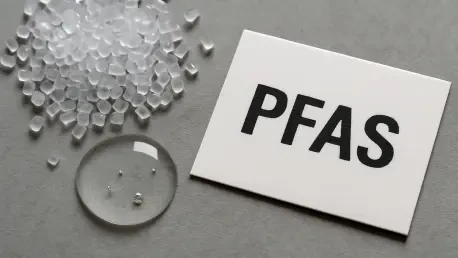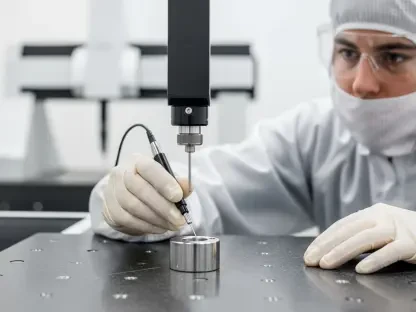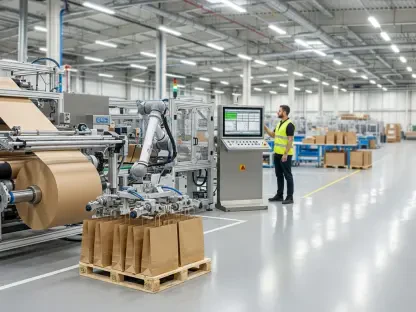In today’s rapidly advancing industrial landscape, the challenge of managing per- and polyfluoroalkyl substances (PFAS) looms large over manufacturers. Known as “forever chemicals,” PFAS are notorious for their resistance to breaking down due to their strong chemical bonds, posing significant environmental and public health concerns. These substances have been detected in various ecosystems, from groundwater to human bloodstreams, triggering a wave of scrutiny and regulatory action aimed at curbing their proliferation. As manufacturers grapple with this pressing dilemma, a focus on innovative destruction technologies and regulatory compliance has become essential for sustainable operational practices.
The Regulatory Pressure Mounts
Scrutiny and Action Against PFAS
The escalated regulatory landscape, particularly in the U.S., is pushing manufacturers to urgently address and mitigate PFAS occurrences in their operations. The Environmental Protection Agency (EPA) has identified specific PFAS compounds like PFOA and PFOS as hazardous, amplifying the call to effectively dispose of and obliterate these substances. These designations have increased regulatory pressure, urging manufacturers to adopt measures that limit PFAS discharges into the environment and adhere to stringent effluent guidelines. The evolving regulatory framework is compelling manufacturers to not only concentrate on PFAS removal from waste streams but also devise strategies that meet compliance standards and prevent costly penalties.
Regulatory emphasis has driven the exploration and adoption of diverse technologies designed to break down PFAS compounds in varied waste matrices. Solutions range from conventional methods such as incineration to more advanced techniques like plasma destruction. Such approaches are instrumental in aiding industries to tackle these “forever chemicals.” Nevertheless, the technical maturity of these solutions varies, demanding careful consideration from stakeholders regarding effectiveness, cost, and potential environmental impacts. Regulators are fostering an environment that encourages technological innovation by recognizing validated destruction methods, thus positioning compliance-centric strategies as imperatives in safeguarding ecosystem health.
Key Techniques in PFAS Destruction
Supercritical water oxidation (SCWO) has emerged as one of the most promising technologies in the arsenal against PFAS. Pioneered by companies like Revive Environmental in tandem with Battelle Memorial Institute, SCWO demonstrates high efficiency, boasting a 99.99% destruction rate for PFAS in liquid waste streams. A noteworthy aspect of this technology is its assurance of no harmful by-products, aligning with regulatory demands for safe waste processing. The SCWO method decomposes PFAS almost instantaneously, offering a potent and reliable solution for manufacturing sectors aiming to reduce ecological contamination.
The validation from accredited third-party laboratories plays a crucial role in enhancing the credibility of PFAS destruction technologies, which is essential as the regulatory landscape continues to evolve. Industry experts acknowledge destruction as an indispensable strategy to prevent PFAS re-entry into the environment. This sentiment underscores the strategic advantages of adopting SCWO and similar cutting-edge methods, which provide the dual benefits of compliance assurance and environmental protection. By leveraging these validated technologies, manufacturers can effectively navigate the complex interplay of regulatory compliance requirements and corporate sustainability goals.
Emerging Technologies and Innovations
Exploring Novel Approaches
The realm of PFAS management is witnessing a surge of innovative technologies striving to address contamination challenges more efficiently. Gradiant’s ForeverGone technology exemplifies this trend by implementing micro-foam fractionation combined with electro-oxidation, which adeptly isolates and eliminates PFAS from contaminated water. Such innovations focus on in-situ treatment capabilities, highlighting the potential for versatile and adaptive solutions that cater to distinct industrial scenarios. Gradiant’s approach underscores the momentum towards holistic water treatment methodologies that are not only technically advanced but also economically viable for widespread adoption.
In addition to water treatment breakthroughs, pyrolysis-based technologies have gained traction as robust methods for PFAS decomposition. Bioforcetech’s sigma pyrolysis unit, for instance, utilizes high-temperature processes devoid of oxygen to dismantle chemical bonds, thus preventing reformation of PFAS. This approach underscores the move toward environmentally responsible practices by harnessing by-products of the pyrolysis process for sustainable energy production. As industries strive to minimize their carbon footprint, such innovations illustrate the potential for integrated solutions that concurrently address chemical destruction and energy recovery, aligning with global sustainability benchmarks.
Overcoming Adoption Barriers
Despite the proliferation of sophisticated PFAS destruction technologies, industry hesitancy towards full-scale adoption persists. A notable barrier is the uncertainty regarding the scope of PFAS contamination issues across different sectors, which often leads companies to delay technological investments until compelled by regulatory mandates. Moreover, the nuanced understanding required for selecting appropriate technologies further complicates decision-making, particularly when balancing considerations of efficacy, cost, and potential regulatory changes.
Manufacturers leading the charge in adopting these technologies typically belong to tightly regulated industries or maintain a substantial public focus. Many of these entities prefer performance-based contracts that allow them to mitigate risk by only paying for results rather than owning the technology outright. This model encourages collaboration with technology providers who oversee system operations, offering a pragmatic approach to managing PFAS mitigation efforts. As the regulatory environment evolves, firms must proactively explore emerging technologies and consider strategic partnerships that leverage expertise and innovation to stay ahead of compliance requirements.
Shifting Towards Sustainable Alternatives
Phasing Out PFAS
The long-term resolution to the PFAS conundrum increasingly emphasizes the elimination of these compounds from manufacturing processes. Industry leaders recognize the strategic advantage in transitioning towards non-PFAS alternatives as consumer awareness and regulatory scrutiny continue to heighten. The development and adoption of PFAS substitutes present not only a tangible opportunity to preemptively mitigate future regulatory risks but also a pathway to enhancing brand reputation through sustainability initiatives. This trend encourages collaborative efforts between manufacturers, researchers, and policymakers to identify viable alternatives that satisfy performance criteria without compromising environmental integrity.
Collaborative efforts are exemplified by initiatives where companies like Battelle work closely with manufacturers to develop and integrate PFAS-free materials within their product lines. By prioritizing the reduction of PFAS reliance, these collaborations aim to mitigate consumer exposure and strengthen long-term environmental stewardship. This approach signifies a paradigm shift towards proactive measures, positioning companies at the forefront of sustainability while lessening dependency on harmful chemicals. As this transition gains momentum, it exemplifies the necessity for industries to not only invent technological solutions but also engage in forward-thinking strategies that redefine the foundation of manufacturing processes.
The Role of Consumer and Industry Awareness
The push towards sustainable alternatives is buoyed by rising consumer demand for environmentally friendly products and heightened industry-wide awareness about PFAS implications. Increasing public concern regarding chemical safety propels manufacturers to be more transparent about PFAS usage and their commitment to seeking sustainable solutions. This awareness fuels demands for regulatory bodies to enforce stricter standards, driving a feedback loop that urges industries to prioritize innovation for the greater ecological good.
Meanwhile, manufacturers face the dual challenge of managing current PFAS liabilities while innovatively transitioning towards safer alternatives. Success in this realm requires a balanced approach encompassing technological prowess and adaptive business models that reflect evolving market and regulatory expectations. As consumer sentiment grows more environmentally conscious, manufacturers that effectively integrate alternative solutions are likely to experience competitive advantages and enhanced stakeholder trust. The convergence of technological innovation, regulatory alignment, and consumer advocacy plays a pivotal role in charting a sustainable path for industries grappling with the PFAS challenge.
Steering Towards a PFAS-Free Future
In the modern industrial world, manufacturers face the significant challenge of dealing with per- and polyfluoroalkyl substances (PFAS), often referred to as “forever chemicals.” These complex compounds are incredibly difficult to break down, largely due to their robust chemical bonds, and this trait poses serious threats to both the environment and public health. PFAS have been discovered in various ecosystems, ranging from groundwater to human blood, raising alarms and leading to intensified regulatory scrutiny to limit their spread. As manufacturers contend with this urgent issue, it has become vital to focus on pioneering destruction technologies and adhere to strict regulations to ensure sustainable and responsible operations. Strategies might involve developing advanced filtration and degradation methods, investing in research for safer alternatives, and collaborating with policymakers to develop effective strategies for mitigating PFAS’s impact on the environment and society.









